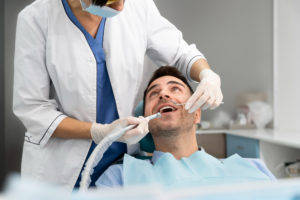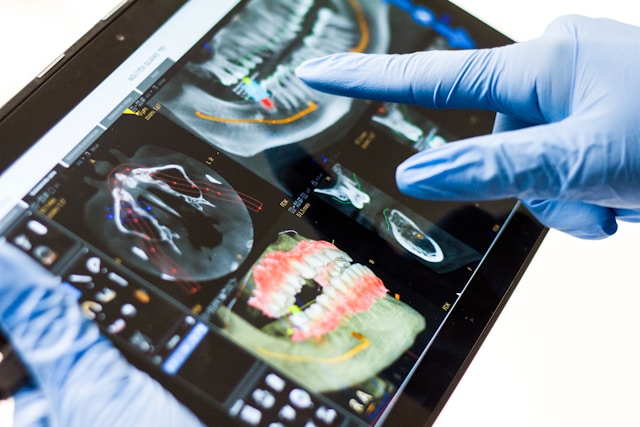Gum recession is a common dental issue, mostly in older people. When the gums pull back from the tooth surface, they expose the tooth roots, making them prone to sensitivity and decay, ultimately leading to tooth loss.
This condition can be alarming, and you may be wondering if it’s possible to regrow gums after they have receded. Let’s explore the potential causes of gum recession and how to manage them.
What Causes Gum Recession?
According to the ADA, about 50% of adults over 30 in the US suffer from a type of gum disease, which is a leading cause of gum recession.
Gum recession can result from various factors like:
- If you don’t brush and floss regularly, it can lead to plaque buildup. This leads to hard calculus formation, causing gums to recede.
- Brushing too hard or using a toothbrush with stiff bristles can wear down the gum tissue over time.
- Inflammatory conditions like gingivitis and periodontitis can destroy the gum tissue and the surrounding bone that supports teeth.
- Smoking can drastically decrease blood flow to the gums, leading to recession.
- Some individuals may have a genetic predisposition to gum recession.
- Rapid changes in hormones can make gums more sensitive and prone to recession. This is especially true for women during menstruation.
Do Gums Grow Back After Recession?
The term “regrow gums“ might suggest that gums can regenerate on their own, but this isn’t entirely accurate. However, there are treatments and preventive measures that your dentist can perform. This can help stop further gum recession and protect your oral health.
How Does Your Dentist Diagnose Gum Recession?
Your dentist can measure the amount of gum recession on each tooth using a periodontal probe. The depth of the periodontal pockets will also be measured.
Healthy pockets are usually 1 – 3 millimeters. Gingivitis pockets measure 4 millimeters. Periodontitis pockets measure 5 millimeters or higher.
How to Stop Receding Gums
Your dentist can perform several treatments to prevent further recession and restore gum health:
- Scaling and Root Planing: This procedure involves expunging plaque and tartar from the teeth and above and below the gum line. When the etiology is removed, the gums reattach to the tooth surface. It’s an effective method to regrow gums. In fact, it’s the first and mandatory step in managing the gum recession.
- Gum Grafting: In severe cases, your dentist may recommend a gum graft. This surgical procedure involves processing tissue from another part of your mouth, like the palate, to cover the receded areas. In some cases, sterilized human donor tissues may be used as graft material.
- Pinhole Surgical Technique (PST): This is a minimally invasive surgical procedure. A small hole is made in the gum tissue and repositioned over the exposed roots. PST is a popular option as it requires less recovery time than traditional gum grafting.
- Periodontal Pocket Reduction Surgery: When your gums have pulled away from your teeth, a pocket forms between your tooth and gingiva. This becomes an area of debris and bacterial accumulation.
The gums won’t regrow on their own to fill the space made by the pocket. Your dentist will remove the debris and tissue. The damaged bone will be recontoured to allow the gum tissue to reattach. - Desensitizing Toothpaste: For those experiencing sensitivity due to gum recession, using desensitizing toothpaste can help reduce discomfort. This doesn’t regrow gum but can make daily activities like eating and drinking more comfortable.
Preventive Measures: How to Protect Your Gums
Preventing further gum recession is crucial. You can keep your gum healthy in the following ways:
- Practice Good Oral Hygiene: Brushing twice daily with a soft-bristled toothbrush and flossing regularly can prevent plaque buildup. Don’t brush too hard with a stiff-bristled toothbrush. Gentle circular motions are best for protecting gum tissue.
- Visit Your Dentist Regularly: Regular dental check-ups and cleanings can catch gum recession early and prevent it from worsening.
- Quit Smoking: Tobacco is a significant risk factor for gum recession. Quitting smoking can drastically improve blood flow to the gums, promoting overall oral health.
- Maintain a Healthy Diet: Consuming a balanced diet supports gum health. For example, foods with high levels of Vitamin C can strengthen gum tissue and help prevent recession.
When to Seek Professional Help?

Gum recession can lead to serious issues, including tooth decay, infection, and even tooth loss.
If you notice any indications of gum recession, such as increased sensitivity, visible roots, or changes in the appearance of your gums, it’s time to go to your dentist.
The earlier gum recession is detected, the better the chances are of managing it effectively. Early intervention can prevent further recession and protect your teeth and gums from more severe problems.
Conclusion
While it’s not possible to regrow gums naturally after they have receded, there are effective treatments and preventive measures to stop further recession and protect your oral health. You can prevent severe dental and gum issues by maintaining oral hygiene and having regular dental checkups.
If you are looking for professional treatment for gum recession, look no further. Our dentists at RiverRockDental can address all your gum recession problems and perform additional procedures for dental crowns and bridges. As your trusted dentist, we will help you achieve a pain-free smile.
Contact us today to book a consultation!
Our address: 403 1st Ave East Shakopee, MN 55379






